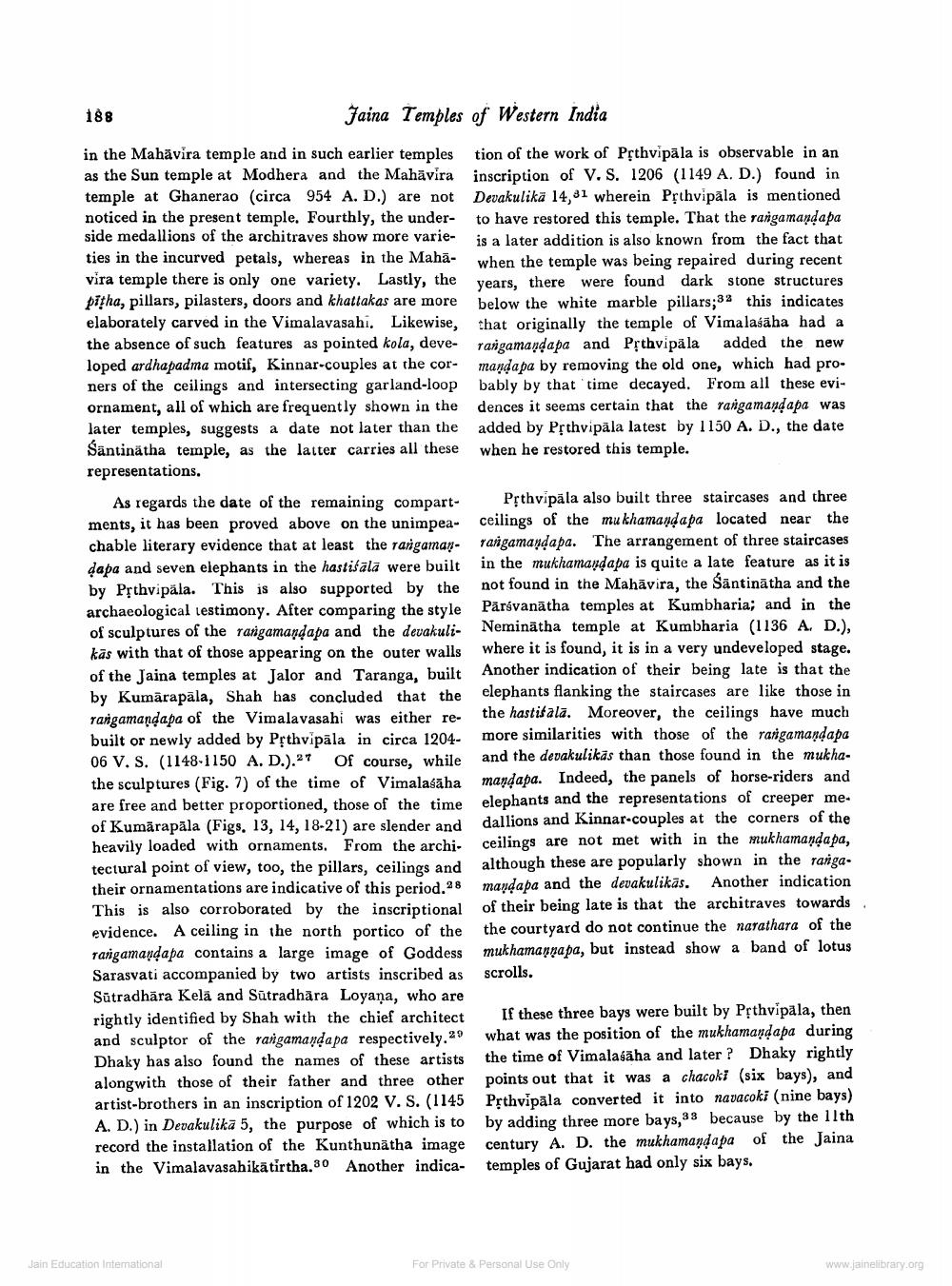________________
188
Faina Temples of Western India in the Mahävira temple and in such earlier temples tion of the work of Ppthvipäla is observable in an as the Sun temple at Modhera and the Mahāvira inscription of V.S. 1206 (1149 A. D.) found in temple at Ghanerao (circa 954 A. D.) are not Devakulika 14,31 wherein Pệthvipāla is mentioned noticed in the present temple. Fourthly, the under- to have restored this temple. That the rangamandapa side medallions of the architraves show more varie- is a later addition is also known from the fact that ties in the incurved petals, whereas in the Mahā when the temple was being repaired during recent vira temple there is only one variety. Lastly, the years, there were found dark stone structures pitha, pillars, pilasters, doors and khattakas are more below the white marble pillars;32 this indicates elaborately carved in the Vimalavasahi. Likewise, that originally the temple of Vimalasäha had a the absence of such features as pointed kola, deve- rangamandapa and Pythvipă la added the new loped ardhapadma motif, Kinnar-couples at the cor- manda pa by removing the old one, which had proners of the ceilings and intersecting garland-loopbably by that time decayed. From all these eviornament, all of which are frequently shown in the dences it seems certain that the rangamandapa was later temples, suggests a date not later than the added by Pythvipāla latest by 1150 A. D., the date Santinātha temple, as the latter carries all these when he restored this temple. representations.
As regards the date of the remaining compart- Prthvipāla also built three staircases and three ments, it has been proved above on the unimpea- ceilings of the mukhamanda pa located near the chable literary evidence that at least the rangaman- rangamandapa. The arrangement of three staircases dapa and seven elephants in the hastišala were built in the mukhamandapa is quite a late feature as it is by Prthvipäla. This is also supported by the not found in the Mahāvira, the Säntinātha and the archaeological testimony. After comparing the style Pärsvanātha temples at Kumbharia; and in the of sculptures of the rangamandapa and the devakuli- Neminātha temple at Kumbharia (1136 A, D.), kās with that of those appearing on the outer walls
where it is found, it is in a very undeveloped stage. of the Jaina temples at Jalor and Taranga, built Another indication of their being late is that the by Kumarapala, Shah has concluded that the elephants flanking the staircases are like those in Tangamandapa of the Vimalavasahi was either re- the hastifala. Moreover, the ceilings have much built or newly added by Pệthvipäla in circa 1204- more similarities with those of the rangamandapa 06 V.S. (1148-1150 A. D.).27 Of course, while and the devakulikäs than those found in the mukha. the sculptures (Fig. 7) of the time of Vimalasāha mandapa. Indeed, the panels of horse-riders and are free and better proportioned, those of the time elephants and the representations of creeper me. of Kumārapāla (Figs. 13, 14, 18-21) are slender and dallions and Kinnar-couples at the corners of the heavily loaded with ornaments. From the archi- ceilings are not met with in the mukhamandapa, tectural point of view, too, the pillars, ceilings and although these are popularly shown in the rangatheir ornamentations are indicative of this period.28 mandapa and the devakulikās. Another indication This is also corroborated by the inscriptional of their being late is that the architraves towards evidence. A ceiling in the north portico of the the courtyard do not continue the narathara of the Tangamandapa contains a large image of Goddess mukhamannapa, but instead show a band of lotus Sarasvati accompanied by two artists inscribed as scrolls. Sūtradhāra Kela and Sūtradhāra Loyana, who are rightly identified by Shah with the chief architect If these three bays were built by Pộthvipala, then and sculptor of the rangamanda pa respectively.29 what was the position of the mukhamandapa during Dhaky has also found the names of these artists the time of Vimalasäha and later ? Dhaky rightly alongwith those of their father and three other points out that it was a chacoki (six bays), and artist-brothers in an inscription of 1202 V. S. (1145 Pythvipāla converted it into navacoki (nine bays) A. D.) in Devakulika 5, the purpose of which is to by adding three more bays, 3 because by the 11th record the installation of the Kunthunātha image century A. D. the mukhamandapa of the Jaina in the Vimalavasahikātirtha.30 Another indica- temples of Gujarat had only six bays.
Jain Education International
For Private & Personal use only
www.jainelibrary.org




